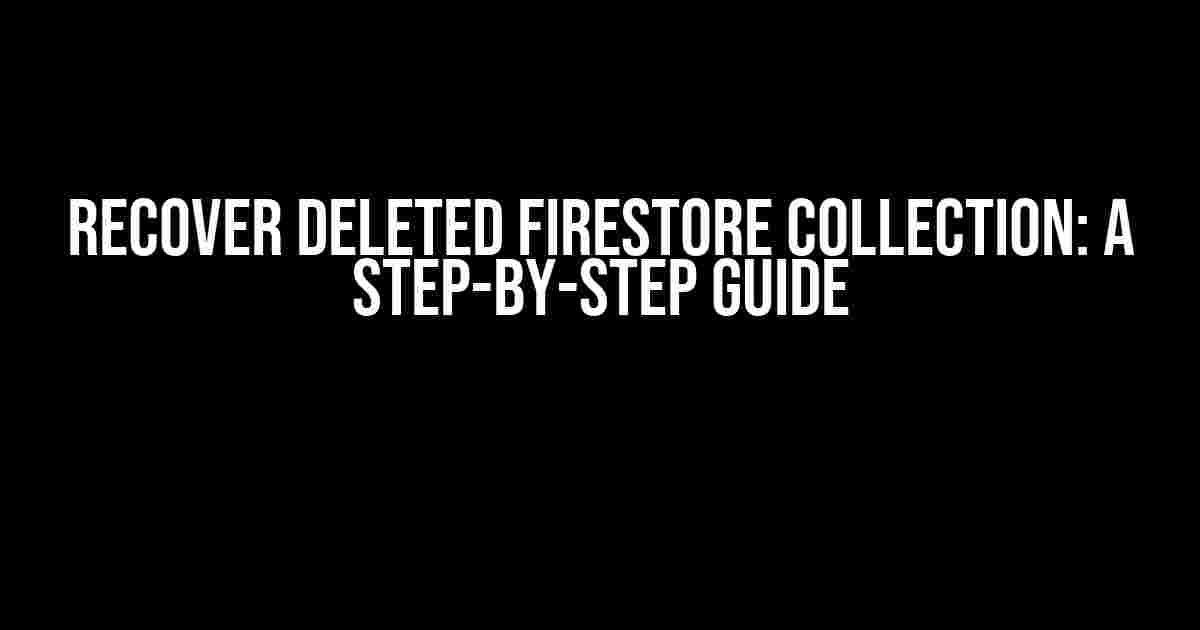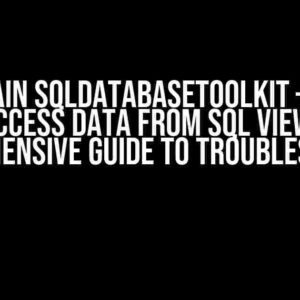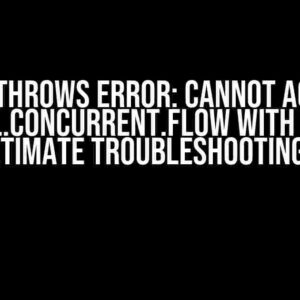Oh no! You’ve accidentally deleted a crucial Firestore collection and now you’re left wondering how to recover it. Don’t panic! In this article, we’ll walk you through a step-by-step process to help you recover your deleted Firestore collection.
Before We Begin
Before we dive into the recovery process, it’s essential to understand the following:
- The recovery process requires the Firebase CLI and Firebase console access.
- This guide assumes you have basic knowledge of Firestore and Firebase CLI.
Recovery Methods
There are two methods to recover a deleted Firestore collection:
Method 1: Using Firebase Console
This method is applicable if you have not enabled version history for your Firestore database.
Step 1: Navigate to the Firebase Console
In your Firebase console, navigate to the Firestore section and select the database that contains the deleted collection.
Step 2: Go to the “Data” Tab
Click on the “Data” tab and select the collection that you want to recover. You will see a timestamped list of all previous versions of the collection.
Step 3: Select the Desired Version
Select the desired version of the collection that you want to recover. You can do this by clicking on the three vertical dots at the end of each version and selecting “Restore.”
Step 4: Confirm Restoration
A pop-up will appear asking you to confirm the restoration. Click “Restore” to begin the process.
Note: This method only works if you have not enabled version history for your Firestore database.
Method 2: Using Firebase CLI
This method is applicable if you have enabled version history for your Firestore database.
Step 1: Install Firebase CLI
If you haven’t already, install the Firebase CLI using npm or yarn:
npm install -g firebase-tools
Step 2: Enable Version History
Make sure you have enabled version history for your Firestore database. You can do this using the following command:
firebase firestore:version-history --enable
Step 3: List All Versions
List all versions of the deleted collection using the following command:
firebase firestore:version-history --collection-group=<COLLECTION_NAME> --format=table
Step 4: Restore Desired Version
Restore the desired version of the collection using the following command:
firebase firestore:version-history --restore --collection-group=<COLLECTION_NAME> --version=<VERSION_NUMBER>
Replace <COLLECTION_NAME> with the name of your collection and <VERSION_NUMBER> with the desired version number.
Troubleshooting Common Issues
While recovering a deleted Firestore collection, you may encounter the following issues:
Issue 1: Firebase Console Not Showing Deleted Data
If the Firebase console is not showing the deleted data, try the following:
- Check if you have enabled version history for your Firestore database.
- Verify that you are using the correct Firebase project and database.
- Try using the Firebase CLI to recover the data.
Issue 2: Firebase CLI Not Restoring Data
If the Firebase CLI is not restoring the data, try the following:
- Check if you have entered the correct collection name and version number.
- Verify that you have enabled version history for your Firestore database.
- Try using the Firebase console to recover the data.
Best Practices for Preventing Data Loss
To avoid data loss in the future, follow these best practices:
Conclusion
Recovering a deleted Firestore collection can be a daunting task, but with the right tools and knowledge, it’s possible to get your data back. Remember to stay calm, follow the steps outlined in this guide, and take necessary precautions to prevent data loss in the future.
By following these steps, you should be able to recover your deleted Firestore collection and get back to developing your application with confidence.
| Method | Prerequisites | Steps |
|---|---|---|
| Method 1: Firebase Console | No version history required | 1. Navigate to Firebase Console 2. Go to “Data” tab 3. Select desired version 4. Confirm restoration |
| Method 2: Firebase CLI | Version history required | 1. Install Firebase CLI 2. Enable version history 3. List all versions 4. Restore desired version |
If you’re still having trouble recovering your deleted Firestore collection, don’t hesitate to reach out to Firebase support for further assistance.
Frequently Asked Question
Don’t panic! Losing important data can be frustrating, but we’re here to help you recover your deleted Firestore collection.
Can I recover a deleted Firestore collection?
Yes, it is possible to recover a deleted Firestore collection, but you’ll need to act fast! Firestore provides a 30-day window to retrieve deleted data. After that, it’s gone forever. So, don’t wait – follow our recovery guide to get your data back.
How do I restore a deleted Firestore collection?
To restore a deleted Firestore collection, you can use the Firestore Console or the Firebase CLI. The Firebase CLI provides more advanced options, allowing you to restore specific collections or documents. Make sure you have the necessary permissions and follow the official Firebase documentation to avoid any mistakes.
What happens to my data after 30 days?
After 30 days, your deleted Firestore data is permanently removed and cannot be recovered. This is a critical deadline, so don’t delay – take action to restore your data as soon as possible.
Can I recover individual documents within a deleted Firestore collection?
Unfortunately, it’s not possible to recover individual documents within a deleted Firestore collection. When you delete a collection, all documents within it are also deleted. However, if you have a backup or a cache of your data, you might be able to recover specific documents.
How can I prevent accidental deletions in the future?
To prevent accidental deletions, implement data backups, use Firestore security rules to restrict access, and set up recurring exports. Additionally, consider using a version history or change logs to track changes to your data. By being proactive, you can minimize the risk of data loss and ensure business continuity.





